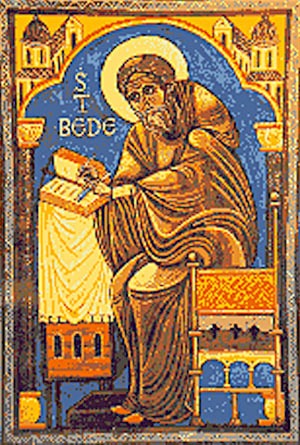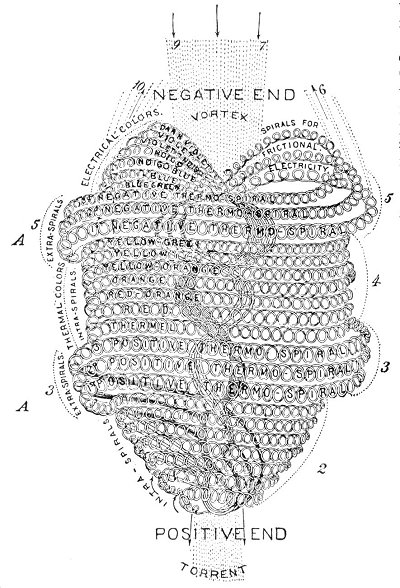In Chapter 7 we pass to a fresh missionary enterprise. Birinus, sent to Britain by Pope Honorius, converts the West Saxons. Their king, Cynegils, is baptized, and a see is established at Dorchester, in Oxfordshire. Under Coinwalch, the successor of Cynegils, the province passes through various vicissitudes, political and ecclesiastical, and finally the West Saxon see is fixed at Winchester.
In Kent, Earconbert succeeds Eadbald in 640 A.D., and takes vigorous measures for the suppression of idolatry. His daughter, Earcongota, and many other high-born English ladies enter the religious life in Gaul, for convents are still scarce in England.
In Chapter 9, reverting to the history of Northumbria, Bede tells us of the death of Oswald at Maserfelth in 642, and relates at length various miracles wrought by his relics. Oswald is succeeded by Oswy in Bernicia and in Deira by Oswin. The latter is treacherously murdered by Oswy; his character is described. The death of Aidan (in 651) immediately follows that of his beloved king; Aidan’s miracles are related, and a warm tribute is paid to his character, in spite of the inevitable error with regard to Easter, which is severely condemned.
In Chapter 18, passing again to East Anglian history, we hear of King Sigbert’s services to education, and of his retirement to a monastery from which he was forcibly drawn to fall in battle against the Mercians. (The chronology is here very vague.) A vision of the Irish St. Fursa, who founded the monastery of Cnobheresburg in East Anglia is told in detail. Changes in the episcopate in East Anglia and elsewhere are mentioned. Deusdedit succeeds Honorius as Archbishop of Canterbury in 654.
Again, a Northumbrian prince gives a fresh impulse to the spread of Christianity. In 653 the Middle Angles (who occupied a part of Mercia) are converted, their prince, Peada, being persuaded chiefly by his brother-in-law, Alchfrid, a son of Oswy. Four priests are sent to them to preach and baptize, Cedd, Adda, Betti, and Diuma, and Diuma becomes bishop of the Middle Angles and Mercians. Similarly, at this time, King Sigbert of Essex listens to the exhortations of his friend, King Oswy, and, at the preaching of Cedd, the East Saxons receive the faith a second time. Cedd becomes their bishop. Sigbert’s tragic death is related. His successor, Suidhelm, receives baptism at the hands of Cedd. The foundation of Lastingham by Ethelwald of Deira and its consecration by Cedd are described. Cedd dies of the plague of 664.
Meanwhile, important political changes have taken place in the north: the defeat and death of Penda at the Winwaed in 655 are followed by Oswy’s rule, which established Christianity in Mercia, in spite of a successful rebellion after three years, when the Mercians threw off the yoke of Northumbria and set up Penda’s son, Wuifhere, as their king.
In Chapter 25 we come to the Synod of Whitby (664 A.D.), which settled the Easter question for the English Church. Wilfrid comes to the front as a champion of the Catholic rules. The opposing party either retire or conform. The self-denial and devotion of the Celtic missionaries are highly praised, and some account of the life led by English students in Ireland follows, with the story of the self-dedication of Egbert, who is destined to play a prominent part afterwards in the history of the Church.
The consecration of both Wilfrid and Ceadda (664 A.D.), as bishops of Northumbria leads to complications in the episcopate. An important step towards the unity of the English nation in ecclesiastical matters is taken when Wighard is sent to Rome by the kings Oswy and Egbert, acting in concert, to be consecrated as Archbishop of Canterbury (667 A.D.). Wighard dies there, and Pope Vitalian undertakes to find an archbishop for the English Church.
The book ends with a fresh apostasy in Essex during the miseries of the great plague of 664. Mercia, so lately itself evangelized, becomes a new missionary centre, King Wulfhere sending Bishop Jaruman to recall the East Saxons to the faith.
BOOK IV.—In all but one of the kingdoms of England Christianity is now, at least in name, established, and the Church settles down to the work of organization. The man for this task is found in Theodore of Tarsus, consecrated Archbishop of the English in 668. He arrives at Canterbury in 669. We hear at once of the vigorous impulse given by him and Abbot Hadrian to the various departments of education there. Finding an irregularity in Ceadda’s orders, he completes his ordination and makes him Bishop of the Mercians (probably in 669), with his see at Lichfield. Ceadda’s death (672 A.D.), his character, and the miracles and visions connected with him are described. Parenthetically we get an account of Colman’s activity in Ireland after his retirement, in consequence of the decision at Whitby. The most important political events at this time are the death of Oswy and succession of Egfrid in Northumbria in 670 or 671, and the death of Egbert and succession of Hlothere in Kent in 673.

Moe is the founder of GnosticWarrior.com. He is a father, husband, author, martial arts black belt, and an expert in Gnosticism, the occult, and esotericism.




